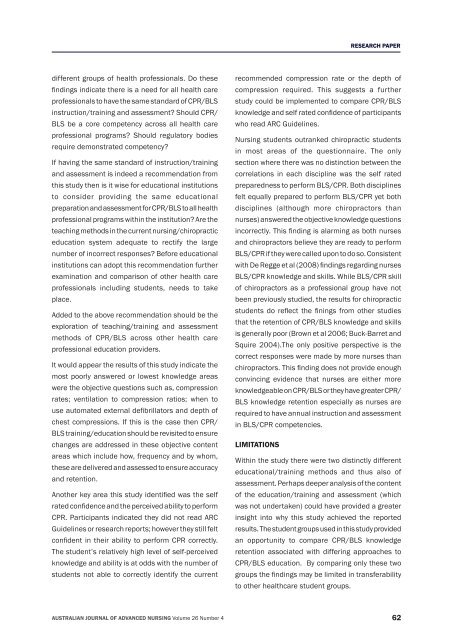australian journal of advanced nursing
australian journal of advanced nursing
australian journal of advanced nursing
Create successful ePaper yourself
Turn your PDF publications into a flip-book with our unique Google optimized e-Paper software.
different groups <strong>of</strong> health pr<strong>of</strong>essionals. Do these<br />
findings indicate there is a need for all health care<br />
pr<strong>of</strong>essionals to have the same standard <strong>of</strong> CPR/BLS<br />
instruction/training and assessment? Should CPR/<br />
BLS be a core competency across all health care<br />
pr<strong>of</strong>essional programs? Should regulatory bodies<br />
require demonstrated competency?<br />
If having the same standard <strong>of</strong> instruction/training<br />
and assessment is indeed a recommendation from<br />
this study then is it wise for educational institutions<br />
to consider providing the same educational<br />
preparation and assessment for CPR/BLS to all health<br />
pr<strong>of</strong>essional programs within the institution? Are the<br />
teaching methods in the current <strong>nursing</strong>/chiropractic<br />
education system adequate to rectify the large<br />
number <strong>of</strong> incorrect responses? Before educational<br />
institutions can adopt this recommendation further<br />
examination and comparison <strong>of</strong> other health care<br />
pr<strong>of</strong>essionals including students, needs to take<br />
place.<br />
Added to the above recommendation should be the<br />
exploration <strong>of</strong> teaching/training and assessment<br />
methods <strong>of</strong> CPR/BLS across other health care<br />
pr<strong>of</strong>essional education providers.<br />
It would appear the results <strong>of</strong> this study indicate the<br />
most poorly answered or lowest knowledge areas<br />
were the objective questions such as, compression<br />
rates; ventilation to compression ratios; when to<br />
use automated external defibrillators and depth <strong>of</strong><br />
chest compressions. If this is the case then CPR/<br />
BLS training/education should be revisited to ensure<br />
changes are addressed in these objective content<br />
areas which include how, frequency and by whom,<br />
these are delivered and assessed to ensure accuracy<br />
and retention.<br />
Another key area this study identified was the self<br />
rated confidence and the perceived ability to perform<br />
CPR. Participants indicated they did not read ARC<br />
Guidelines or research reports; however they still felt<br />
confident in their ability to perform CPR correctly.<br />
The student’s relatively high level <strong>of</strong> self‑perceived<br />
knowledge and ability is at odds with the number <strong>of</strong><br />
students not able to correctly identify the current<br />
RESEARCH PAPER<br />
recommended compression rate or the depth <strong>of</strong><br />
compression required. This suggests a further<br />
study could be implemented to compare CPR/BLS<br />
knowledge and self rated confidence <strong>of</strong> participants<br />
who read ARC Guidelines.<br />
Nursing students outranked chiropractic students<br />
in most areas <strong>of</strong> the questionnaire. The only<br />
section where there was no distinction between the<br />
correlations in each discipline was the self rated<br />
preparedness to perform BLS/CPR. Both disciplines<br />
felt equally prepared to perform BLS/CPR yet both<br />
disciplines (although more chiropractors than<br />
nurses) answered the objective knowledge questions<br />
incorrectly. This finding is alarming as both nurses<br />
and chiropractors believe they are ready to perform<br />
BLS/CPR if they were called upon to do so. Consistent<br />
with De Regge et al (2008) findings regarding nurses<br />
BLS/CPR knowledge and skills. While BLS/CPR skill<br />
<strong>of</strong> chiropractors as a pr<strong>of</strong>essional group have not<br />
been previously studied, the results for chiropractic<br />
students do reflect the finings from other studies<br />
that the retention <strong>of</strong> CPR/BLS knowledge and skills<br />
is generally poor (Brown et al 2006; Buck‑Barret and<br />
Squire 2004).The only positive perspective is the<br />
correct responses were made by more nurses than<br />
chiropractors. This finding does not provide enough<br />
convincing evidence that nurses are either more<br />
knowledgeable on CPR/BLS or they have greater CPR/<br />
BLS knowledge retention especially as nurses are<br />
required to have annual instruction and assessment<br />
in BLS/CPR competencies.<br />
LIMITATIONS<br />
Within the study there were two distinctly different<br />
educational/training methods and thus also <strong>of</strong><br />
assessment. Perhaps deeper analysis <strong>of</strong> the content<br />
<strong>of</strong> the education/training and assessment (which<br />
was not undertaken) could have provided a greater<br />
insight into why this study achieved the reported<br />
results. The student groups used in this study provided<br />
an opportunity to compare CPR/BLS knowledge<br />
retention associated with differing approaches to<br />
CPR/BLS education. By comparing only these two<br />
groups the findings may be limited in transferability<br />
to other healthcare student groups.<br />
AUSTRALIAN JOURNAL OF ADVANCED NURSING Volume 26 Number 4 62

















